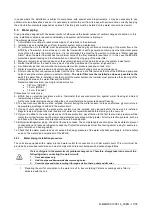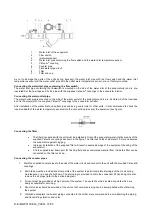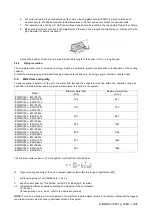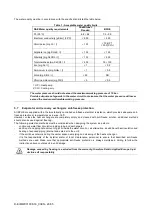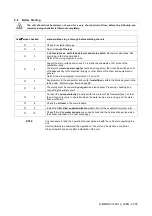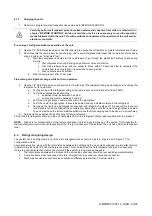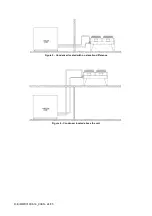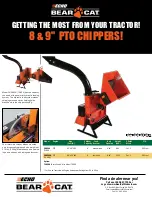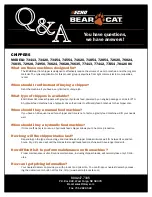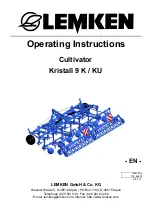
D-EIMWC01008-16_03EN - 9/35
The chillers are built in accordance with the main European Directives (Machinery Directive, Low Voltage Directive,
Electromagnetic Compatibility Directive, Pressurized Equipment Directive), make sure you also receive the declaration of
product conformity with the directives along with the documentation.
Before machine installation and commissioning, the people involved in this activity must have acquired the
information necessary to carry out these tasks, applying all the information collected in this book. Do not allow
unauthorized and/or unskilled personnel to access the unit.
The chiller has to be installed in open air or machinery room (location classification III).
To ensure location classification III a mechanical vent on the secondary circuit(s) has to be installed.
Local building codes and safety standards shall be followed; in absence of local codes and standards refer to EN 378-
3:2016 as a guide. In paragraph “Additional guidelines for safe use of R1234ze(E)” there are provided additional
information that should be added to the requirements of safety standards and building codes.
2.2.1
Additional guidelines for safe use of R1234ze(E) for equipment located in the open air
Refrigerating systems sited in the open air shall be positioned to avoid leaked refrigerant flowing into a building or
otherwise endangering people and property.
The refrigerant shall not be able to flow into any ventilation fresh air opening, doorway, trap door or similar opening in th e
event of a leak. Where a shelter is provided for refrigerating equipment sited in the open air it shall have natural or forced
ventilation.
For refrigeration systems installed outside in a location where a release of refrigerant can stagnate e.g., below ground,
then the installation shall comply with the requirements for gas detection and v entilation of machinery rooms.
2.2.2
Additional guidelines for safe use of R1234ze(E) for equipment located in a machinery room
When a machinery room is chosen for the location of the refrigerating equipment it shall be located in accordance with
local and national regulations. The following requirements (according to EN 378-3:2016) can be used for the assessment.
•
A risk analysis based on the safety concept for the refrigerating system (as determined by the manufacturer and
including the charge and safety classification of the refrigerant used) shall be conducted to determine whether it
is necessary to place the refrigerating system in a separate refrigeration machinery room.
•
Machinery rooms should not be used as occupied spaces. The building owner or user shal l ensure that access is
permitted only by qualified and trained personnel doing the necessary maintenance to the machinery room or
general plant.
•
Machinery rooms shall not be used for storage with the exception of tools, spare parts and compressor oil for the
installed equipment. Any refrigerants, or flammable or toxic materials shall be stored as required by national
regulations.
•
Open (naked) flames shall not be permitted in machinery rooms, except for welding, brazing or similar activity
and then only provided the refrigerant concentration is monitored and adequate ventilation is ensured. Such open
flames shall not be left unattended.
•
A remote switching (emergency type) for stopping the refrigerating system shall be provided outside the room
(near the door). A similar acting switch shall be located at a suitable location inside the room.
•
All piping and ducting passing through floors, ceiling and walls of machinery room shall be sealed.
•
Hot surfaces shall not exceed a temperature of 80 % of the auto-ignition temperature (in °C) or 100 K less than
the auto-ignition temperature of the refrigerant, whichever is higher.
Refrigerant
Auto ignition temperature Maximum surface temperature
R1234ze
368 °C
294 °C
•
Machinery rooms shall have doors opening outward and sufficient in number to ensure freedom for persons to
escape in an emergency; the doors shall be tight fitting, self-closing and so designed that they can be opened
from inside (antipanic system).
•
Special machinery rooms where the refrigerant charge is above the practical limit for the volume of the room
shall have a door that either opens directly to the outside air or through a dedicated vestibule equipped with
self-closing, tight-fitting doors.
•
The ventilation of machinery rooms shall be sufficient both for normal operating conditions and emergencies.
•
Ventilation for normal operating conditions shall be in accordance with national regulations.
•
The emergency mechanical ventilation system shall be activated by a detector(s), located in the machi nery
room.
o
This ventilation system shall be:
▪
independent of any other ventilation system on the site.
▪
provided with two independent emergency controls one located outside the machinery room,
and the other inside.

















